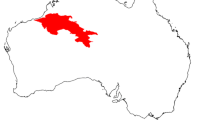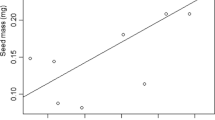Abstract
Dormancy in the hard seed coats of Mediterranean species is considered a strategy that enables persistent seed banks to be formed in the soil. An important factor related to seed coat fracture and dormancy breakage in Mediterranean ecosystems is heat. Nevertheless, the effect of factors other than heat on dormancy breakage in these species has hardly been studied. To investigate the different ecological factors involved in germination, in the laboratory we applied several scarification treatments to seeds with chromatic polymorphism. We evaluated the effect of soil seed depth during experimental burns by sowing seeds at −1, −3 and −5 cm in the soil profile, and we also studied the effect of seed origin on the posterior germination of seeds from 4 and 10 year-old shrubs as well as from the soil seed bank. U. parviflorus shows clear chromatic polymorphism: its brown seeds present higher dormancy levels than its yellow seeds. The different techniques of dormancy breakage result in different degrees of germination; the highest degree of germination is generated by the mechanical treatment, followed by the acid and the heat treatments, in that order. The depth of the seeds in the soil determines the temperature thresholds and the residence times of these temperatures and whether they stimulate a massive germination at the −1 cm soil profile or only a slight germination at the −5 cm depth. Seeds recently produced by the plant show higher dormancy levels than seeds extracted from soil seed banks. Dormancy levels also depend on the shrubland age used for extracting the soil samples (3>9 years old). In effect, from the point of view of dormancy, the germination behaviour of U. parviflorus seeds seems to follow a multiresponse strategy based on different seed populations and involving both biological and abiotic processes to break dormancy.
Similar content being viewed by others
References
Auld T.D. and O’Connell M.A. (1991). Predicting patterns of post-fire germination in 35 eastern Australian Fabaceae. Australian Journal of Ecology 16:53–70
Baeza M.J., De Luís M., Raventós J. and Escarré A. (2002). Factors influencing fire behaviour in shrublands of different stang ages and the implications for using prescribed burning to reduce wildfire risk. Journal of Environmental Management 65:199–208
Baeza M.J., Raventós J., Escarré A. and Vallejo V.R. (2003). The effect of shrub clearing on the control of the fire-prone species Ulex parviflorus. Forest Ecology and Management 186:47–59
Baeza M.J., Raventós J., Escarré A. and Vallejo V.R. In press. Fire risk and vegetation structural dynamics in Mediterranean shrubland. Plant Ecol.
Ballini C. (1992). Écophysiologie de la germination des graines d’Ulex parviflorus Pourr. Bulletin d’Ecologie 23(3–4):119–130
Baskin C. and Baskin M. (1998). Seeds: Ecology, Biogeography and Evolution of Dormancy and Germination. Academic Press, London
Bradstock R.A., Auld T.D., Ellis M.E. and Cohn J.S. (1992). Soil temperatures during bushfires in semi-arid, mallee shrublands. Australian Journal of Ecology 17:433–440
Bradstock R.A. and Auld T.D. (1995). Soil temperatures during experimental bushfires in relation to fire intensity: consequences for legume germination and fire management in south-eastern Australia. Journal of Applied Ecology 32:76–84
De Luís M., Raventós J. and González-Hidalgo J.C. 2005. Factors controlling seedling germination after fire in Mediterranean gorse shrublands. Implications for fire prescription. J. Environ. Manage
De la Torre A. and Alías L. (1996). Suelos y vegetación en el Alto Vinalopó. Alicante. Servicio de Publicaciones de la Universidad de Alicante, Alicante
Escudero A., Carnes L.F. and Pérez-García F. (1997). Seed germination of gypsophytes and gypsovags in semi-arid central Spain. Journal of Arid Environments 36:487–497
Fenner M. (1985). Seed Ecology. Chapman & Hall, USA
González-Rabanal F., Casal M. and Trabaud L. (1994). Effects of high temperatures ash and seed position in the inflorescence on the germination of three Spanish grasses. Journal of Vegetation Science 5:289–294
Goo M. (1948). Effects of individual seed weight and seed coat on the germination of the seed collected from the young and old mother trees in Cryptomeria japonica D. Don. Bull. Tokyo Univ. For. 36:1–10
Grime J.P. (1989). Seed Banks in Ecological Perspective. In: Leck M.A., Parker V.T., Simpson R.L. (eds) Ecology of soil seed banks. Academic Press, London, pp. XV-XXII
Gutiérrez D. (1994). Efecto del tratamiento térmico y del tamaño de la semilla sobre la germinación de Ulex europaeus L. y U. gallii Planchon. Studia Oecologica X-XI:241–246
Hanley M. and Fenner M. (1998). Pre-germination temperature and the survivorship and onward growth of Mediterranean fire-following plan species. Acta Oecologica. 19(2):181–187
Herrera, J. 1985. Biología reproductiva del matorral de Doñana. Ph.D Thesis. Universidad de Sevilla. Spain
Hodgkinson K.C. and Oxley R.E. (1990). Influence of fire and edaphic factors on germination of the arid zone shrubs Acacia aneura, Cassia nemophila and Dodonaea viscosa. Australian Journal of Botany 38:269–279
Holmes P.M. (1989). Effects of different clearing treatments on the seed bank dynamics of an invasive Australian shrub, Acacia cyclops, in the southwestern cape, South Africa. Forest Ecology and Management 28:33–46
Holmes P.M. and Moll E.J. (1990). Effect of deph and duration of burial on alien Acacia saligna and Acacia cyclops seeds. South African Journal of Ecology 1:12–17
Hossaert-Palauqui M. (1980). Régénération d’une lande après incendie. II- Reproduction sexuée et capacité de germination d’Ulex minor Roth. (Ulex nanus Sm). Bulletin d’Ecologie 11(3):387–392
Ivens G.W. (1983). The influence of temperature on germination of gorse (Ulex europaeus L.). Weed Research 23:207–216
Kazanis D. and Arianoutsou M. (1996). Vegetation composition in a post-fire successional gradient of Pinus halepensis forest in Attica, Greece. International Journal of Wildland Fire 6(2):83–91
Keddy P.A., Wisheu I.C., Shipley B. and Gaudet C. (1989). Seed banks and Vegetation Management for Conservation: Toward Predictive Community Ecology. In: Leck M.A., Parker V.T., Simpson R.L. (eds) Ecology of soil seed banks. Academic Press, London, pp. 347–363
Keeley J.E. (1987). Role of fire in seed germination of woody taxa in California chaparral. Ecology 68:434–443
Legesse N. and Powell A.A. (1996). Relationship between the development of seed coat pigmentation, seed coat adherence to the cotyledons and the rate of imbibition during the maturation of grain legumes. Seed Science & Technology 24:23–32
Legrand C. 1990. Strategies of three obligate-seeder shrubs, Cistus albidus L., Ulex parviflorus Pourr., Rosmarinus officinalis L. after wildfire. In: Viegas D.X. (ed.), Proceedings of the 1st International Conference of Forest Fire Research. Coimbra
Martínez-Sanchez J.J., Marín A., Herranz J.M., Ferrandis P. and De las Heras J. (1995). Effects of high temperatures on germination of Pinus halepensis Mill. and P. pinaster Aiton subsp. pinaster seeds in southeast Spain. Vegetatio 116: 69–72
Moore R.P. 1985. Manual de ensayos al tetrazolio. In: Moore R.P (ed.), Instituto Nacional de Semillas y Plantas de Vivero, MAPA, Madrid
Nikolaeva M.G. (1977). Factors controlling the seed dormancy pattern. In: Khan A.A. (eds) The Physiology and Biochemistre of Seed Dormancy and Germination. North-Holland, Amsterdam, pp. 51–74
Olson D.S. (1932). Germinative capacity of seed produced from young trees. Journal of Forestry 30: 871
Parker V.T. and Kelly V.R. (1989). Seed banks in California chaparral and other Mediterranean climate shrubland. In: Leck M.A., Parker V.T., Simpson R.L. (eds) Ecology of soil seed banks. Academic Press, London, pp. 231–255
Pereiras J., Puentes M.A. and Casal M. (1987). Efecto de las altas temperaturas sobre la germinación de las semillas del tojo (Ulex europaeus L.). Studia Oecologica VI: 125–133
Pons T.L. (1989). Dormancy, germination and mortality of seeds in heathlands and inland sand dunes. Acta Botanica Neerlanderiana 38(3):327–335
Portlock C.C., Shea S.R., Majer J.D. and Bell D.T. (1990). Stimulation of germination of Acacia pulchella: Laboratory basis for forest management options. Journal of Applied Ecology 27:319–324
Reyes O., and Casal M. (1995). Germination behaviour of three species of the genus Pinus in relation to high temperatures suffered during forest fires. Annales Sciences Forestieres 52:385–392
Rolston M.P. (1978). Water impermeable seed dormancy. The Botanical Review 44:365–396
Roy J., and Sonie L. (1992). Germination and populations dynamics of Cistus species in relation to fire. Journal of Applied Ecology 29:647–655
Salvador R. and Lloret F. (1995). Germinación en el laboratorio de varias especies arbustivas mediterráneas: efecto de la temperatura. Orsis 10:25–34
Tárrega R.E., Calvo L. and Trabaud L. (1992). Effect of high temperatures on seed germination of two woody Leguminosae. Vegetatio 102:139–147
Thanos C.A., Georghiou K., Kadis C. and Pantazi C. (1992). Cistaceae: A plant family with hard seeds. Israel Journal of Botany 41:251–263
Thompson K. and Grime J.P. (1979). Seasonal variation in the seed banks of herbaceous species in ten contrasting habitats. Journal of Ecology 67:893–921
Todd J.J. and Vodkin L.O. (1993). Pigmented soybean (Glycine max) seed coats accumulate proanthocyanidins during development. Plant Physiology 102:660–670
Trabaud L. (2000). Seeds: their soil bank and their role in post-fire recovery of ecosystems of the Mediterranean basin. In: Trabaud L. (eds) Life and environment in the Mediterranean. Wit Press, Southampton, Boston, pp. 229–259
Trabaud L. and Oustric J. (1989a). Influence du feu sur la germination des semences de quatre espèces ligneuses méditerranéennes à reproduction sexuée obligatoire. Seed Science & Technology 17: 589–599
Trabaud L. and Oustric J. (1989b). Comparison des stratégies de regénération après incendie chez deux espèces de Ciste. Revue d’Ecologie (Terre Vie) 44:3–13
Traveset A., Riera N. and Mas R.E. (2001). Ecology of fruit-colour polymorphism in Myrtus communis and differential effects of birds and mammals on seed germination and seedling growth. Journal of Ecology 89:749–760
Troumbis A.Y. and Trabaud L. 1987). Dynamique de la banque de graines de deux espèces de Cistes dans les maquis grecs. Acta Oecologica 8(22):167–179
Ungar I.A. (1988). Effects of the parental environment on the temperature requirements and salinity tolerance of Spergularia marina seeds. Botanical Gazeta 149(4):432–436
Valero E. 1993. Caracterización Cinética de la Polifenol Oxidasa de Uva Airen: Efecto de Inhibidores. Ph.D Thesis. Universidad de Castilla-La Mancha, Spain
Valbuena L., Tárrega R. and Luis E. (1992). Influence of heat on seed germination of Cistus laurifolius and Cistus ladanifer. International Journal of Wildland Fire 2(1):15–20
Van der Vegte F.W. (1978). Populations differentiation and germination ecology in Stellaria media L. Vill. Oecologia 37:231–245
Venable D.L. and Lawlor L. (1980). Delayed germination and dispersal in desert annuals: Escape in space and time. Oecologia 46:272–282
Whelan R.J. (1995). The Ecology of Fire. Cambridge University Press, New York
Zabkiewicz J.A. and Gaskin R.E. (1978). Effect of fire on gorse seeds. Proceeding of 31ST New Zealand Weed and Pest Control Conference, pp. 47–52
Acknowledgements
We thank J. Scheiding for the English translation of the text, and A. Escarré, J. Raventós and three anonymous referees, who helped to make improvements on an earlier draft of the manuscript. This research has been funded by the European project LUCIFER (ENV4-CT96-0320). CEAM is supported by the Regional Ministry of the Environment (Generalitat Valenciana) and Bancaja.
Author information
Authors and Affiliations
Corresponding author
Rights and permissions
About this article
Cite this article
Baeza, M.J., Vallejo, V.R. Ecological mechanisms involved in dormancy breakage in Ulex parviflorus seeds. Plant Ecol 183, 191–205 (2006). https://doi.org/10.1007/s11258-005-9016-0
Received:
Accepted:
Published:
Issue Date:
DOI: https://doi.org/10.1007/s11258-005-9016-0




